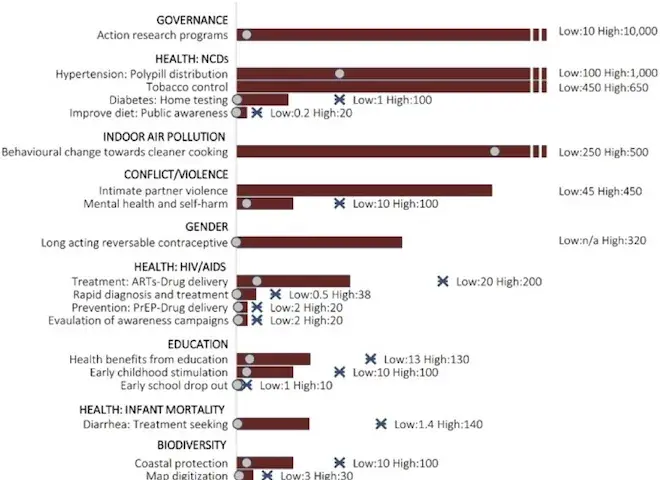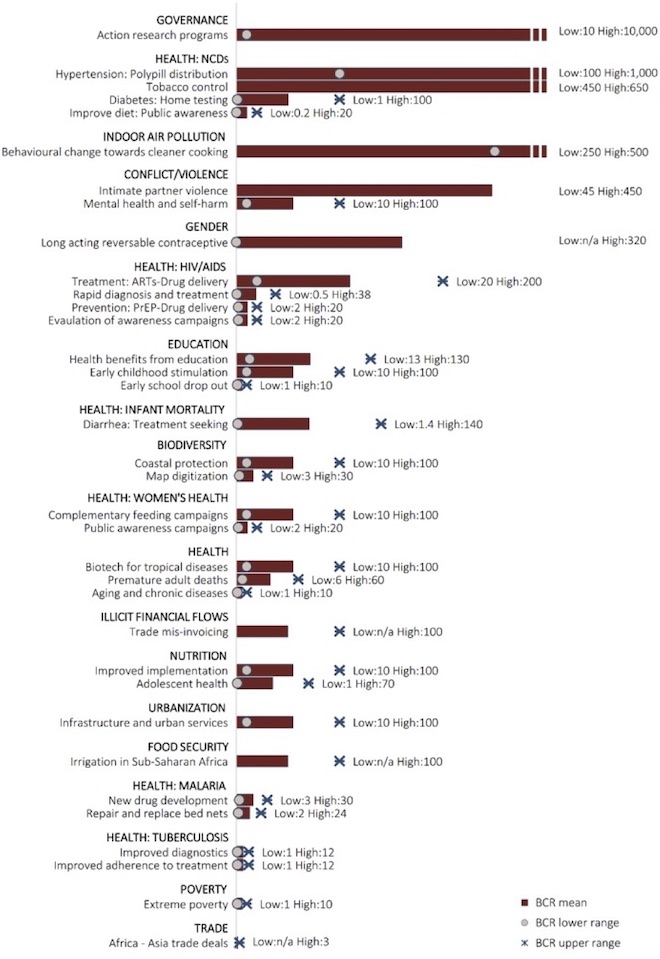Priorities in Research & Development
This part looks at possibilities to further improve yields from existing interventions, and also problems that have more expensive solutions or maybe no feasible solutions at all currently. Here, investment into research and development (R&D) could possibly help make future spending more effective.
The overview below shows 35 areas where R&D might help future spending becoming more effective. It answers where more resources can be invested into R&D to produce most social good.
It should be emphasized that this analysis is very preliminary and estimated for the world. However, as Africa has a significant part of both the global challenges and will stand to gain much from cheaper ways to tackle these challenges, it is likely that much of the global estimates will be similarly applicable for Africa in specific.
The uncertainty of the benefit-cost ratio (BCR) is clear, spanning 1-4 orders of magnitude. This is simply a result of making educated guesses on what is essentially very difficult to predict — what extra R&D can develop of new knowledge and how much and how valuable that will be.
Ongoing iterative R&D in collaboration with implementing governments
Action research is carried out in cooperation with receptive government departments to support program implementation and might produce $5000 of social good per dollar spent. It does so by helping to compress 100s of years of learning into 10 years. It essentially takes the best ideas from across the world and make specific projects better implemented.
R&D into politically feasible tobacco control
About one billion people will die from tobacco in this century, if current smoking patterns persist. R&D could help generate and implement politically feasible solutions, from estimating the most effective and least disruptive tobacco tax increases to creating packaging to reduce consumption. Each dollar spent could produce $550 of social benefits.
R&D to increase distribution and adherence of hypertension polypills
Cardiovascular disease kills almost a million people in Sub-Saharan Africa each year. Hypertension can be treated with a combination of drugs, but a polypill (one pill which contains many) is cheaper and dramatically increase adherence. R&D to increase distribution, by studying different targeting and assessing existing and new distribution mechanisms for treatment could produce $600 of social benefits.
R&D to increase uptake of cleaner cooking
Cooking with poor fuels kills 270,000 people in Sub-Saharan Africa every year, and if we could change cooking habits towards cleaner cooking, we could dramatically lower deaths. R&D would focus on household cooking habits, use of single or multiple burners, awareness and understanding of health effects, time spent cooking, how time is valued in the household, etc. Each dollar spent could produce $425 of social benefits.
R&D to prevent and reduce intimate partner violence
Intimate partner violence is an enormous and often underappreciated problem. Each year it costs $4.4 trillion or 5% of global GDP. Researching and developing better and cheaper ways to cut violence could have a massive impact — for instance, the American SAFE DATEs program has reduced domestic violence among teenagers by 56%. Each dollar could produce $250 in social benefits.
R&D for long-acting reversible contraceptive
If we could develop long acting reversible contraceptive, it could dramatically increase women’s empowerment, their labor market participation and ensure improved health outcomes for the women and their babies. R&D to improve existing technologies and get them to market could generate $160 for every dollar spent.
Download summary for policy makers PDF



